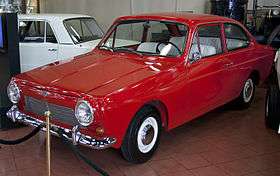Automotive industry in Turkey
The automotive industry in Turkey plays an important role in the manufacturing sector of the Turkish economy. The companies operating in the Turkish automotive sector are mainly located in the Marmara Region.
In 2012, Turkey produced more than 1 million motor vehicles.[1] With a cluster of car-makers and parts suppliers, the Turkish automotive sector has become an integral part of the global network of production bases, exporting nearly $20 billion worth of motor vehicles and components.[1] Global car manufacturers with production plants include Fiat/Tofaş, Oyak-Renault, Hyundai, Toyota, Honda and Ford/Otosan.
The foundations of the industry were laid in the 1950s when TOE (Türk Otomotiv Endüstrileri A.ş.) started producing REO military truck and later trucks by International Harvester. A brief foray in car production was stopped short. In 1961 the first domestic car Devrim was made by a train manufacturer TÜLOMSAŞ. With the establishment of the Otosan assembly factory in 1959, mass production of the domestic car Anadol started in 1966.
History


.jpg)
.jpg)


In 1959 the Otosan factory was established in Istanbul to produce the models of the Ford Motor Company under licence in Turkey.
In 1961 the Devrim sedan was manufactured at the Tülomsaş factory in Eskişehir. It was the first indigenously designed and produced Turkish automobile.
In 1964 the Austin and Morris vehicles of the British Motor Corporation began to be produced under licence at the BMC factory in İzmir. The BMC brand was later fully acquired by Turkey's Çukurova Group in 1989, which currently produces all BMC models in the world.
In 1966 Anadol became the first mass-produced Turkish automobile brand. All Anadol models were produced by the Otosan factory in Istanbul.
In 1968 the Tofaş factory was opened in Bursa for producing Fiat models under licence.
In 1969 the Oyak-Renault factory was established in Bursa for producing Renault models.
Other global automotive manufacturers such as Toyota, Honda, Opel, Hyundai, Mercedes-Benz and MAN AG produce automobiles, vans, buses and trucks in their Turkish factories. There are also a number of Turkish bus and truck brands, such as BMC, Otokar and TEMSA.
By 2004, Turkey was exporting 518,000 vehicles a year, mostly to the European Union member states.[2]
In 2006, the European Investment Bank loaned Tofaş €175 million to jointly develop and produce with PSA Peugeot Citroën and Fiat Auto small commercial vehicles for the European market. The loan, part-financing for total investments estimated at €400 million, was intended to result in an important expansion of the company's production capabilities and create around 5,000 new jobs. The vehicles will be produced at the manufacturing plant of Tofaş in Bursa with an additional, initial, annual capacity of 135.000 cars, due to roll off the assembly line in late 2007.[3]
The first official introduction of Etox Zafer took place on 30 August 2007.
Like in many countries, the car manufacturing industry has been significantly affected by the global financial crisis. In March 2009, Turkey's Automotive Industry Association (OSD) said the automotive production fell by 63% on year in the first two months of 2009, as exports dropped by 61.6% in the same period.[4]
Manufacturers
Active
- Altın Boğa
- Askam
- BMC
- Diardi
- Erkunt
- Etox
- FNSS Defence Systems
- Ford Otosan
- Hyundai
- Imza
- Isuzu
- Karsan
- Marti
- Onuk
- Oscar
- Otokar
- Otoser
- Oyak-Renault
- Özaltin
- TEMSA
- Tofaş
- Toyota
Defunct
Production

Turkey produced 1,124,982 motor vehicles in 2010,[5] ranking as the 7th largest automotive producer in Europe; behind Germany (5,819,614), France (3,174,260), Spain (2,770,435), the United Kingdom (1,648,388), Russia (1,508,358) and Italy (1,211,594), respectively.[6]
In 2008 Turkey produced 1,147,110 motor vehicles, ranking as the 6th largest producer in Europe (behind the United Kingdom and above Italy) and the 15th largest producer in the world.[7][8]
The combined capacity of the 6 companies producing passenger cars stood at 726,000 units per year in 2002, reaching 991,621 units per year in 2006.[9] In 2002, Fiat/Tofaş had 34% of this capacity, Oyak/Renault 31%, Hyundai/Assan and Toyota 14% each, Honda 4%, and Ford/Otosan 3%.
With a cluster of car-makers and parts suppliers, the Turkish automotive sector has become an integral part of the global network of production bases, exporting over $22,944,000,000 worth of motor vehicles and components in 2008.[10][11]
See also
References
- 1 2 "Turkish auto industry at full throttle despite the slowdown in Europe". Invest in Turkey. Retrieved 13 November 2013.
- ↑ "TURKEY: CAR EXPORTS ESTIMATED. | Goliath Business News". Goliath.ecnext.com. 2005-06-08. Retrieved 2011-04-03.
- ↑ "Turkey's car industry in perpetual motion". Eib.org. 2006-06-08. Retrieved 2011-04-03.
- ↑ "Car industry turns into a Turkey - BUSINESS NEW EUROPE". Businessneweurope.eu. 2009-03-27. Archived from the original on 2009-10-15. Retrieved 2011-04-03.
- ↑ Turkish Automotive Production Archived June 11, 2009, at the Wayback Machine., Turkish Automotive Producers' Association
- ↑ "OICA: WORLD MOTOR VEHICLE PRODUCTION BY COUNTRY, 2005-2006." (PDF). Retrieved 2011-04-03.
- ↑ "Türkiye otomotiv sektöründe büyüyor". Ulaşım Online. 2009-06-29. Retrieved 2009-07-06.
- ↑ "2008 PRODUCTION STATISTICS". OICA. Archived from the original on 1 May 2011. Retrieved 2011-04-03.
- ↑ Özpeynirci, Emre (2007-06-27). "Otomotiv üretiminde 17'nciliğe yükseldik, Belçika'yı da geçtik". Hürriyet (in Turkish). Retrieved 2008-08-29.
- ↑ "Otomotiv İhracatı 2008'de 22 Milyar 944 Milyon Dolara Ulaştı". Haberler. Retrieved 2011-04-03.
- ↑ 03.04.2011 Pazar 09:04. "2008'de otomotiv ihracatı rekor kırdı". HaberX. Retrieved 2011-04-03.
